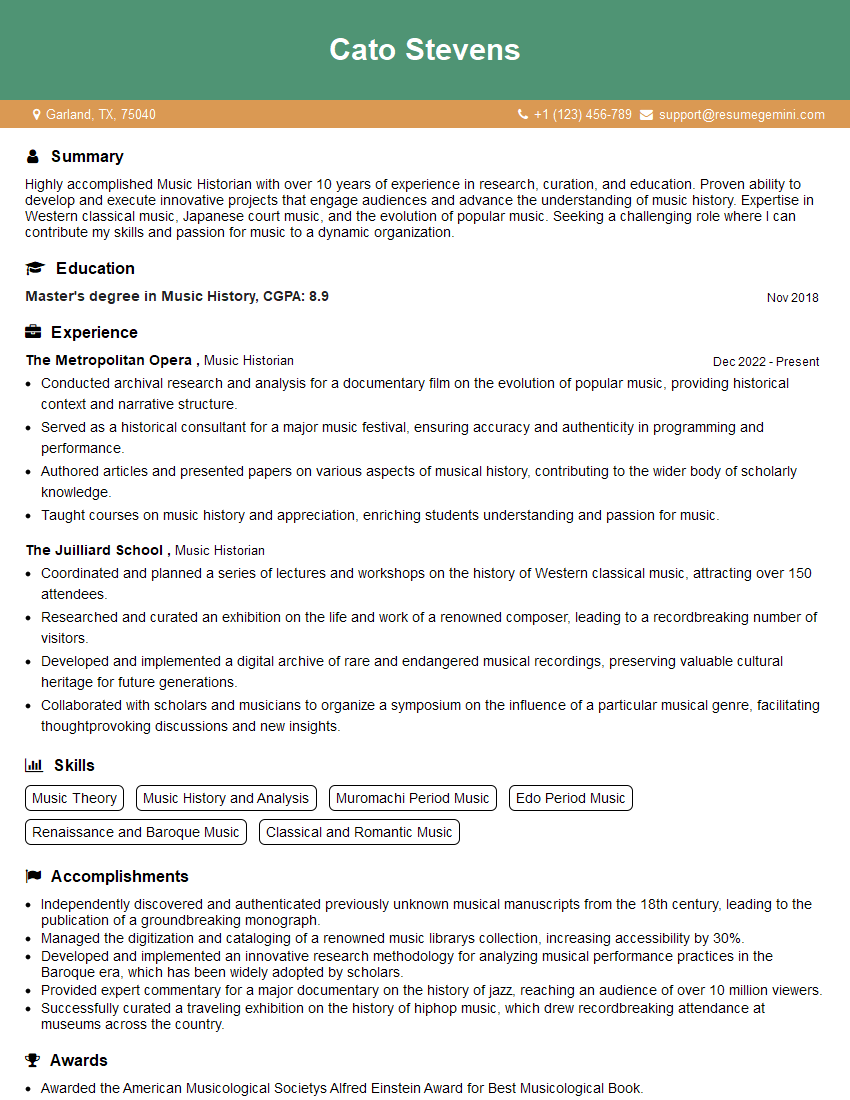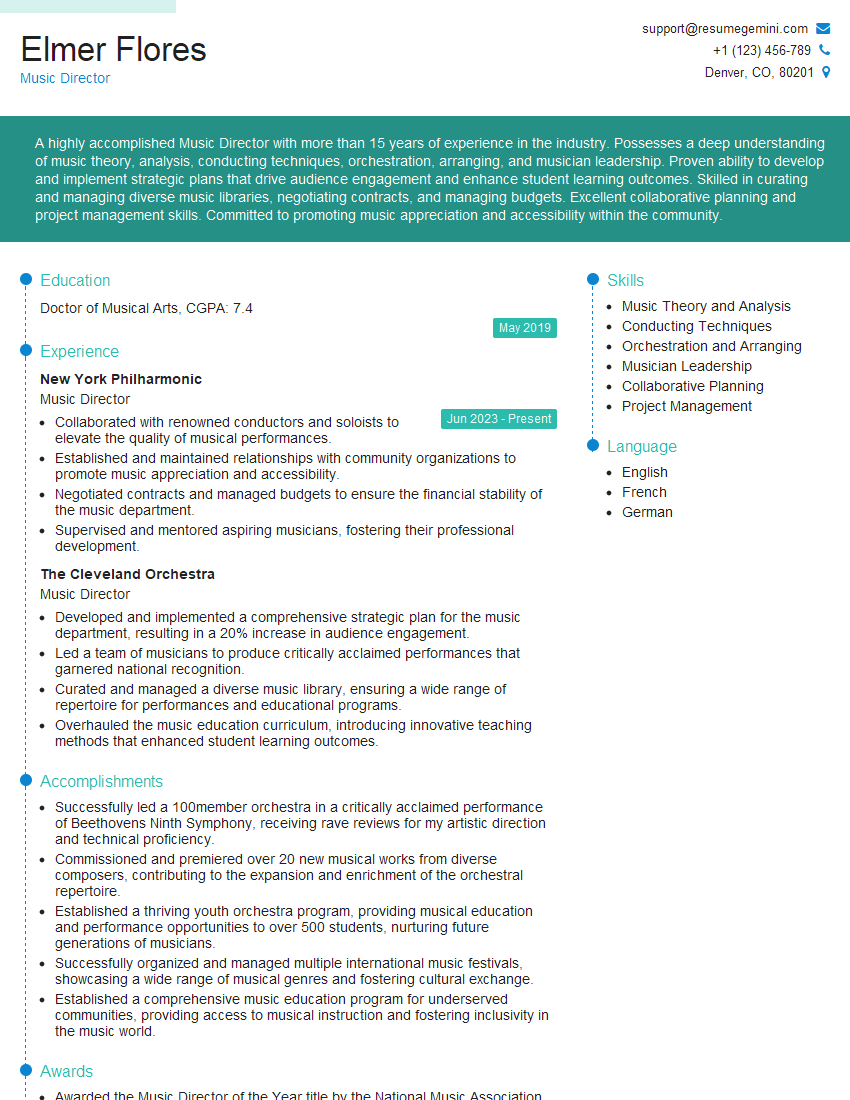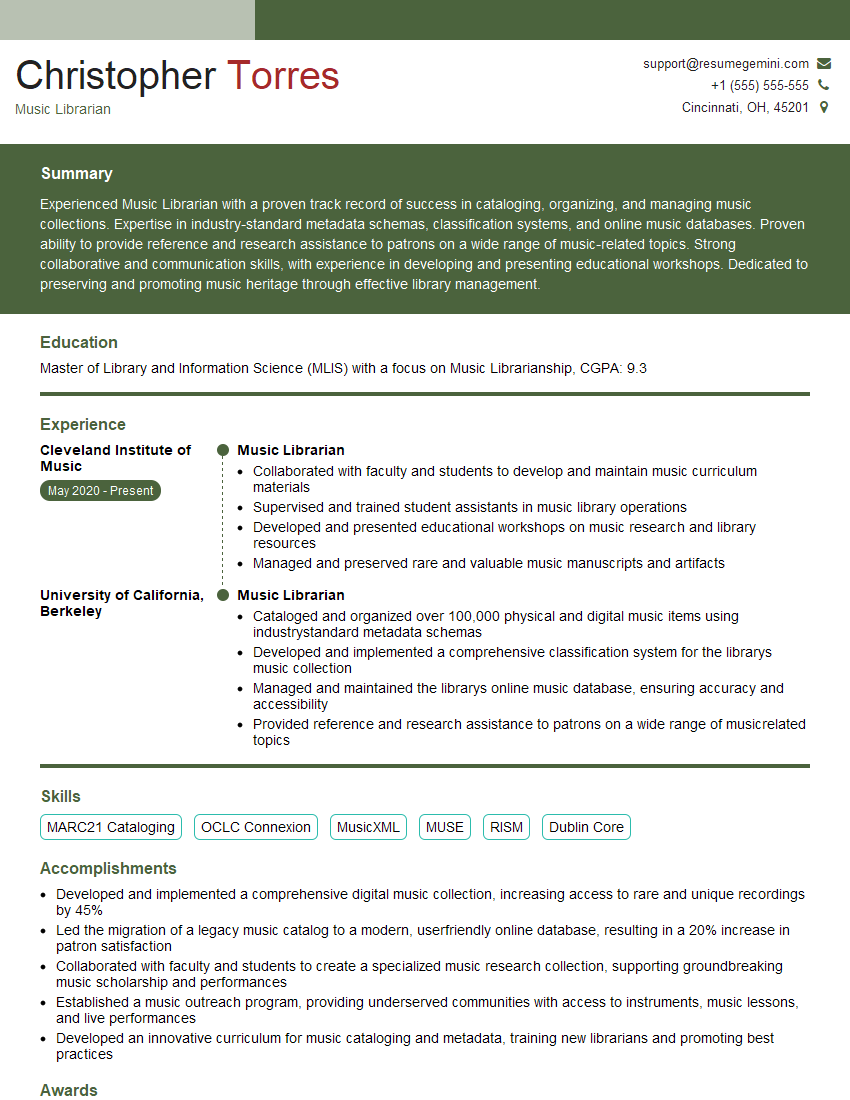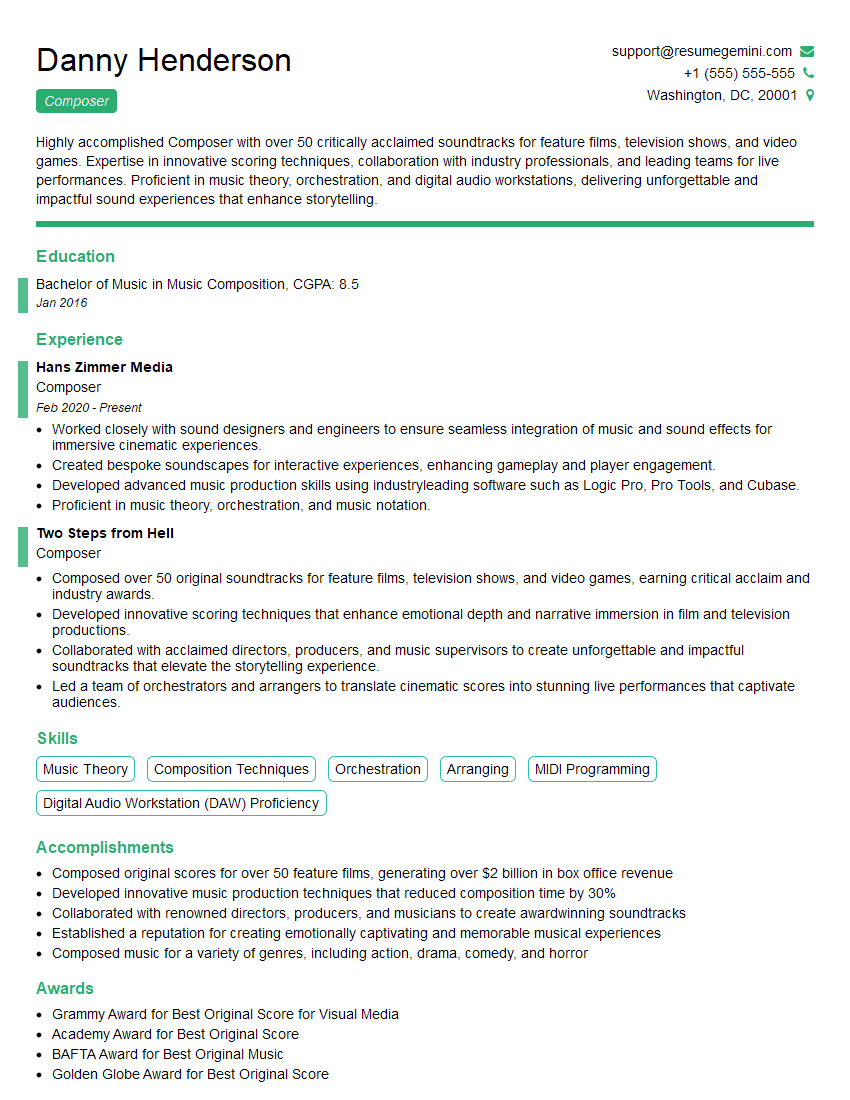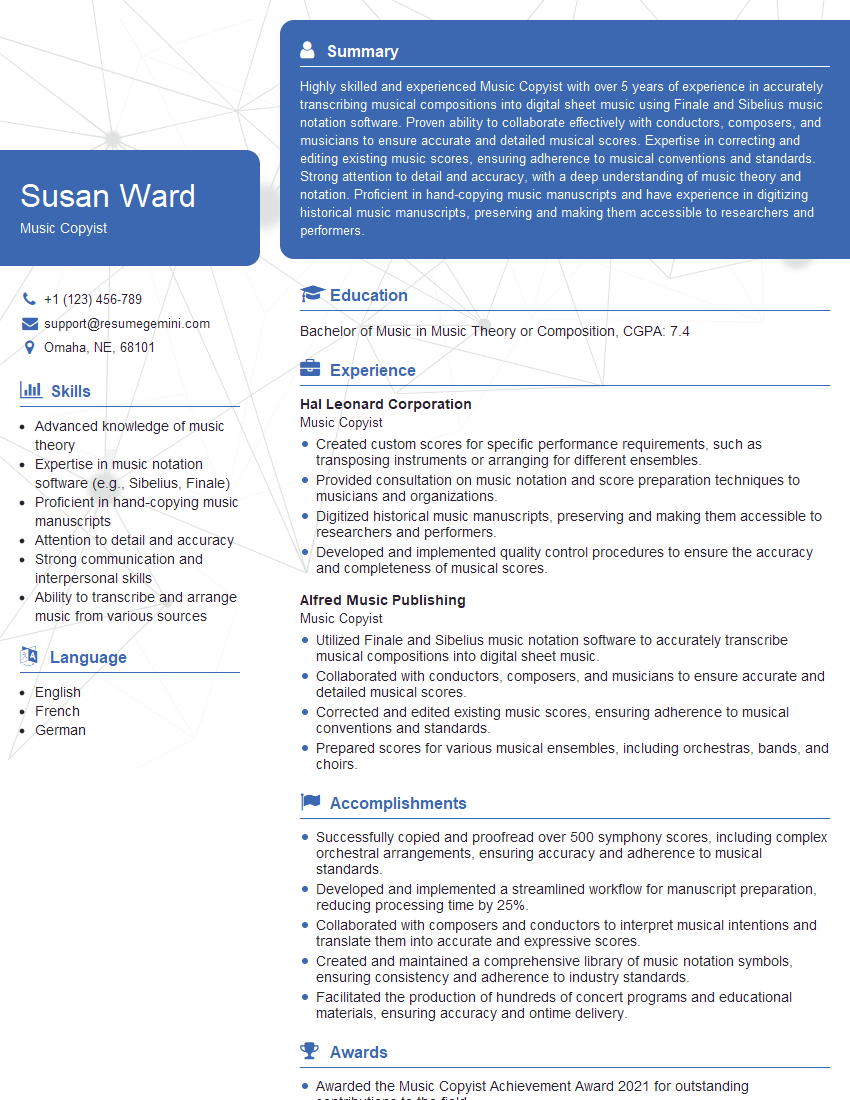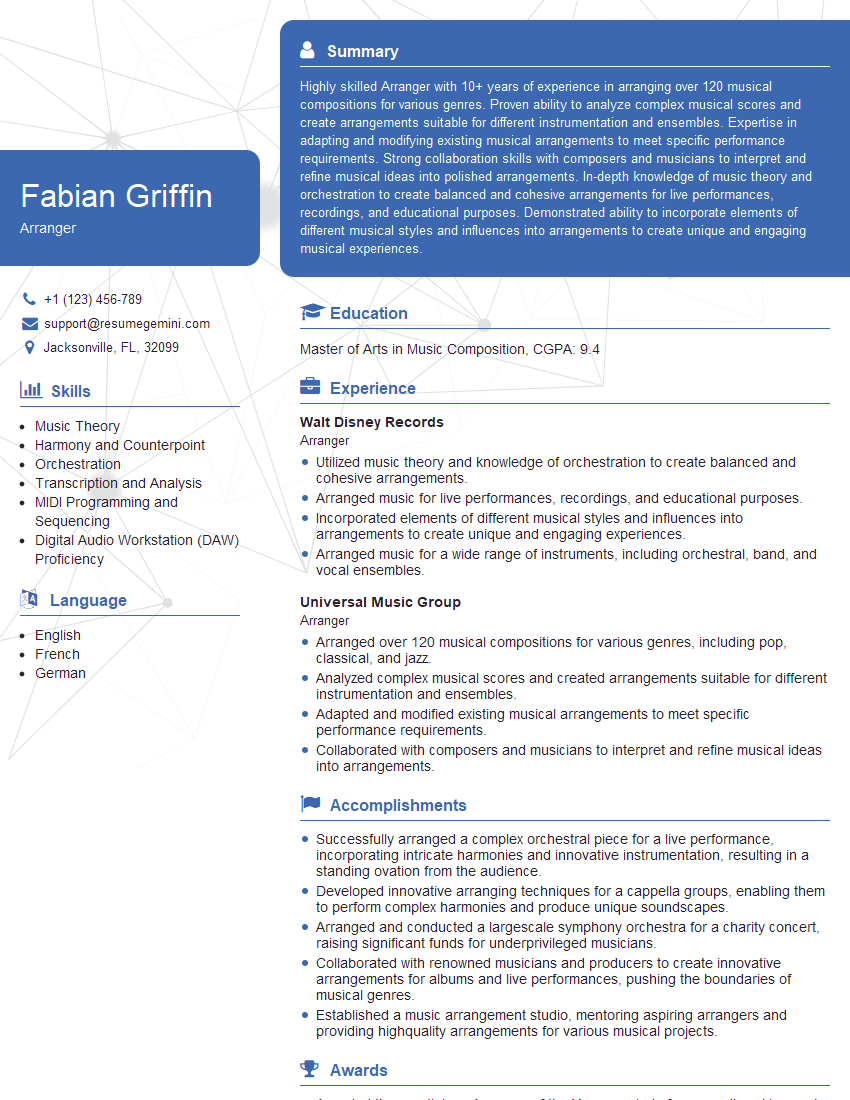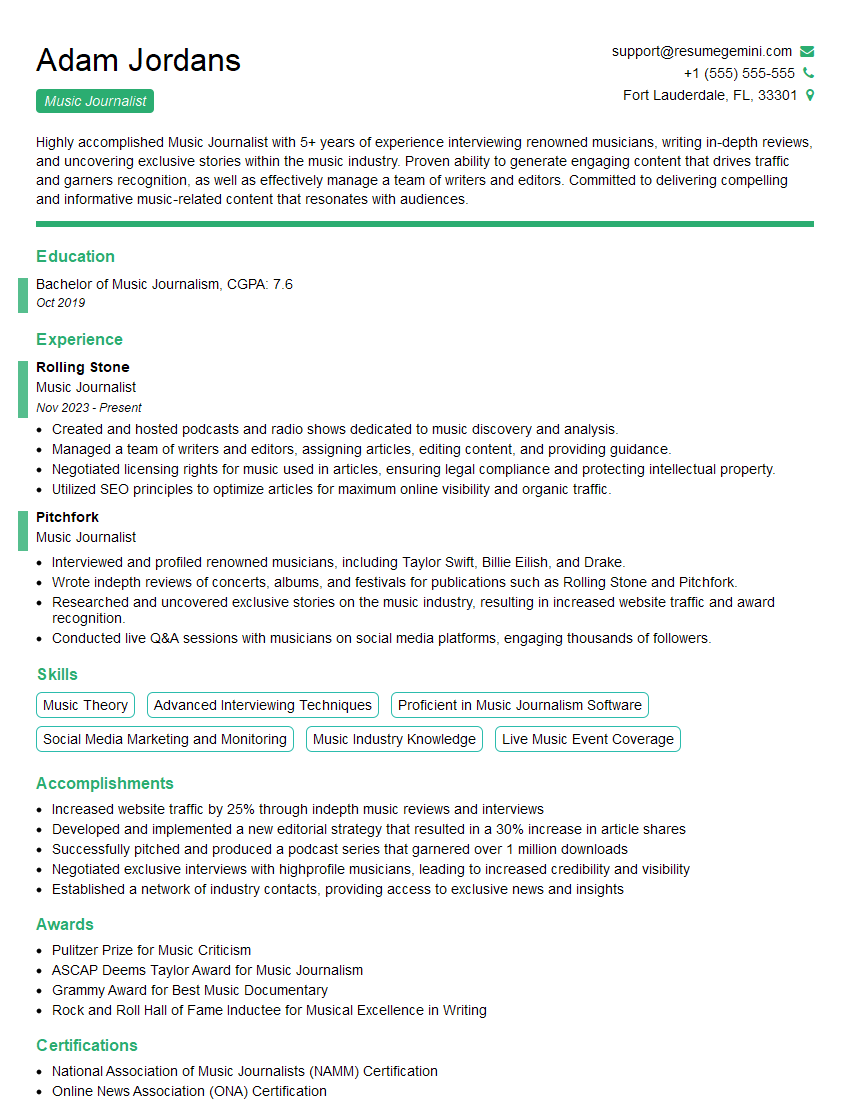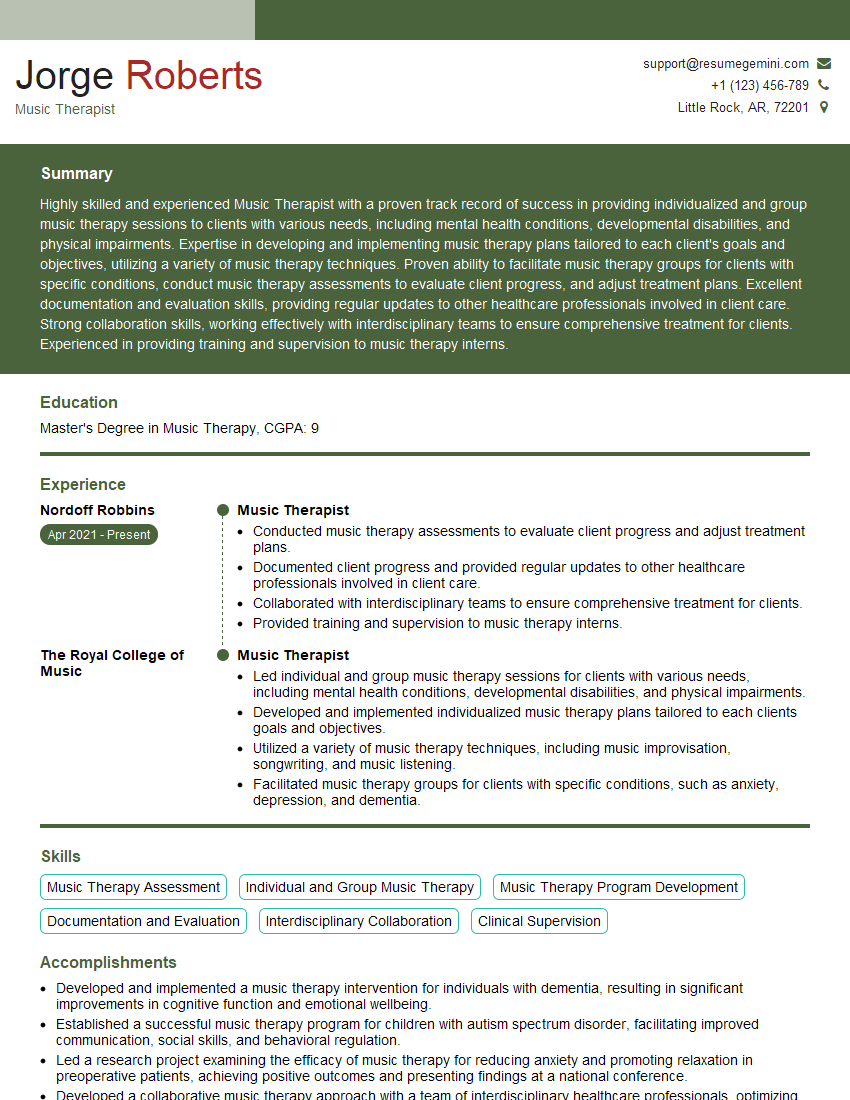Interviews are opportunities to demonstrate your expertise, and this guide is here to help you shine. Explore the essential Repertoire of Standard Jazz, Classical, Contemporary, and Popular Music interview questions that employers frequently ask, paired with strategies for crafting responses that set you apart from the competition.
Questions Asked in Repertoire of Standard Jazz, Classical, Contemporary, and Popular Music Interview
Q 1. Compare and contrast the harmonic language of Debussy and Stravinsky.
Debussy and Stravinsky, though both pivotal figures in 20th-century music, employed vastly different harmonic languages. Debussy, a central figure in Impressionism, favored a fluid, ambiguous harmony often characterized by whole-tone scales, parallel chords, and the avoidance of strong cadences. Think of the shimmering, ethereal quality of his ‘Clair de Lune’. His harmonies often create a sense of suspended resolution, blurring traditional tonal boundaries.
Stravinsky, on the other hand, moved through several stylistic phases, but his early works, particularly those from his Russian period like ‘The Rite of Spring’, are characterized by a more dissonant, percussive, and rhythmically driven harmonic language. He frequently employed polytonality (the simultaneous use of two or more keys), creating jarring clashes and a sense of rhythmic intensity. While Debussy sought to evoke mood and atmosphere, Stravinsky aimed for a more visceral, primal impact.
In short, Debussy’s harmony is characterized by its fluidity and ambiguity, its avoidance of traditional resolution, creating a dreamlike atmosphere; while Stravinsky’s, particularly in his early works, is defined by its dissonance, polytonality, and rhythmic drive, generating a powerful and often jarring effect.
Q 2. Analyze the rhythmic complexities of a specific Charlie Parker solo.
Analyzing the rhythmic complexities of a Charlie Parker solo requires focusing on several key aspects. Let’s take his solo on ‘Ko-Ko’ as an example. Parker’s rhythmic innovation lies in his masterful use of syncopation, swung rhythms, and unexpected rhythmic displacements. He frequently breaks up the expected rhythmic flow of the melody and harmony, creating a sense of surprise and unpredictability.
One technique he employed was the use of rhythmic displacement, where notes are placed slightly off the beat, creating a sense of rhythmic tension and release. He also masterfully utilizes polyrhythms – the simultaneous use of two or more different rhythms – frequently layering complex rhythmic patterns against the underlying harmonic structure. Think of the way he might play a series of triplets against a straight eighth-note bassline.
Furthermore, Parker’s phrasing is characterized by its flexibility and freedom. His phrases often don’t neatly align with the underlying bar lines, instead flowing organically across them, building intensity and creating a highly improvisational feel. His use of rests and silences is also significant, creating space and contrast within the dense rhythmic texture of his solos.
In essence, Parker’s rhythmic approach was revolutionary, combining sophisticated rhythmic techniques with spontaneous phrasing to create a signature style that profoundly influenced generations of jazz musicians.
Q 3. Discuss the evolution of popular music songwriting from Tin Pan Alley to modern pop.
The evolution of popular music songwriting from Tin Pan Alley to modern pop reveals a dramatic shift in both the creative process and the industry structure. Tin Pan Alley, flourishing in the early to mid-20th century, was characterized by a centralized system where composers and lyricists worked in close proximity, creating standardized, catchy tunes with simple, often sentimental lyrics. Songs were typically structured in a verse-chorus format, with a focus on strong melodies and easily memorable hooks –think of the Gershwins or Irving Berlin.
The rise of rock and roll in the 1950s introduced a new era, with greater emphasis on instrumental techniques, and a more rebellious, youth-oriented lyrical content. The advent of recording technology played a key role. The shift towards the singer-songwriter era in the 1960s and 70s further personalized the songwriting process, giving artists more control over their creative output. Bob Dylan exemplifies this shift.
Modern pop music is characterized by a more collaborative process, often involving numerous writers and producers, often working remotely. Technology has democratized music production, leading to a more diverse range of sounds and styles. This evolution also reflects the influence of various musical genres, blending pop with elements of R&B, hip-hop, electronic music and others.
In summary, we’ve moved from a centralized system in Tin Pan Alley producing standardized songs to a more decentralized, collaborative, technologically driven industry creating diverse pop music, influenced by a wide array of musical styles and global trends.
Q 4. Explain the role of counterpoint in Baroque music.
Counterpoint in Baroque music plays a vital role, defining its characteristic texture and complexity. It refers to the art of combining two or more independent melodic lines simultaneously, creating a rich and interwoven musical fabric. Think of the intricate textures in a Bach fugue.
In Baroque counterpoint, each melodic line, or voice, maintains its own independent character and melodic interest, yet interacts harmoniously with the other voices. This interaction creates a sense of interplay and tension, with different voices sometimes harmonizing, sometimes contrasting, sometimes echoing each other.
Several techniques are crucial to Baroque counterpoint. These include imitation (where one voice echoes another), subject and answer (in a fugue), and the careful handling of voice leading to avoid parallel fifths or octaves (dissonances frowned upon in Baroque style) and maintaining a balanced texture. The overall effect is a balance between individuality and unity, where the individual melodic lines contribute to the overall harmonic and structural integrity of the piece. This careful interplay of voices creates a complex and engaging listening experience that’s unique to the Baroque period.
Q 5. Identify three key characteristics of the Romantic era in classical music.
The Romantic era in classical music (roughly 1780-1900), is characterized by three key aspects: intense emotional expression, a focus on individualism and subjective experience, and a broadening of musical forms and instrumentation.
First, intense emotional expression was paramount. Romantic composers aimed to evoke a wide range of feelings, from passionate love and ecstatic joy to deep sorrow and profound despair. This contrasted with the more restrained emotional palette of Classical composers. Think of the dramatic intensity of a Beethoven symphony or the lush romanticism of Chopin’s nocturnes.
Second, individualism and subjective experience were central. Romantic composers frequently expressed their personal thoughts and feelings through their music, seeking to create a unique and intensely personal artistic statement. This led to a greater emphasis on originality and self-expression.
Third, the Romantic era witnessed a broadening of musical forms and instrumentation. New forms emerged, such as the art song (Lied), symphonic poem, and character piece, alongside expanded forms like the symphony and concerto. The orchestra itself grew larger and more versatile, incorporating new instruments and techniques, allowing for a wider range of colors and textures.
Q 6. Describe the influence of blues music on rock and roll.
The influence of blues music on rock and roll is undeniable. The blues provided the foundational elements—the musical language—upon which rock and roll built its identity. This influence manifests in several key ways.
Firstly, the blues’ characteristic twelve-bar harmonic progression became a cornerstone of rock and roll songwriting. Many iconic rock songs utilize variations of this progression, giving them a familiar, yet adaptable framework. Secondly, the blues’ emphasis on call and response vocal phrasing and the use of improvisation directly impacted the development of rock’s vocal and instrumental styles. The passionate vocals and the guitar solos of rock musicians heavily draw on the blues’ improvisational spirit.
Thirdly, the bluesy pentatonic scales and the use of blue notes (slightly bent or flattened notes) became integral to the rock guitar sound. The characteristic distortion and vibrato that emerged in rock guitar playing often directly reflects blues techniques and sensibilities.
In short, the blues provided the harmonic backbone, the rhythmic and melodic vocabulary, and the improvisational spirit that gave birth to rock and roll. Without the blues, rock and roll as we know it would simply not exist.
Q 7. How has technology impacted the creation and dissemination of contemporary music?
Technology has profoundly impacted both the creation and dissemination of contemporary music in numerous ways. Digital audio workstations (DAWs) like Ableton Live, Logic Pro, and Pro Tools have revolutionized music production, allowing musicians to create complex arrangements and record and edit audio with unprecedented precision and flexibility.
The internet and social media platforms have completely changed how music is shared and consumed. Streaming services like Spotify and Apple Music have redefined the music industry, offering listeners unparalleled access to vast libraries of music. Simultaneously, social media platforms such as YouTube, Instagram, and TikTok provide artists with powerful new tools for self-promotion and direct engagement with fans.
Moreover, new instruments and technologies like synthesizers, samplers, and virtual instruments have expanded the sonic palette of contemporary music. These technologies have blurred the lines between genres, enabled the creation of entirely new sounds, and empowered musicians to realize their creative visions with tools previously unavailable. The influence extends even to live performances, with advanced lighting, video technology and immersive sound systems creating ever more spectacular live shows.
In conclusion, technology has democratized music creation, expanded its sonic possibilities, and fundamentally altered the ways in which music is distributed and experienced by audiences worldwide.
Q 8. Compare the compositional techniques of Bach and Beethoven.
Bach and Beethoven, though separated by time and style, both profoundly impacted Western music. Bach, a master of the Baroque period, focused on counterpoint – the weaving of independent melodic lines simultaneously. His compositions are characterized by intricate textures, elaborate ornamentation, and a strong sense of structure based on mathematical principles. Think of the Well-Tempered Clavier, where each prelude and fugue explores the possibilities of a specific key. Beethoven, on the other hand, ushered in the Classical and Romantic periods. While he respected the formal structures of the Classical era, Beethoven expanded the emotional range and dramatic scope of music. He embraced larger orchestral forces, increased dynamic contrasts, and explored deeper emotional depths. His symphonies, like the Eroica, exemplify this shift, showcasing a narrative power and emotional intensity unseen in Bach’s works. In essence, Bach emphasized meticulous craftsmanship and structural intricacy, while Beethoven prioritized emotional expression and dramatic expansion within a sophisticated formal framework.
- Bach: Focus on counterpoint, intricate textures, mathematical structures, formal elegance.
- Beethoven: Expanded emotional range, larger orchestral forces, dramatic contrasts, narrative power.
Q 9. Analyze the use of dissonance in a specific contemporary composition.
Dissonance, the use of notes that clash or sound unpleasant together, is a powerful tool in contemporary music. Let’s analyze its use in Krzysztof Penderecki’s Threnody for the Victims of Hiroshima. This piece uses a technique called ‘cluster chords,’ where many notes are played simultaneously, creating a dense, dissonant texture. This effect is not just randomly thrown together; it serves a specific purpose. The jarring, unsettling sounds evoke the horror and chaos of the atomic bombing. Penderecki employs microtones (intervals smaller than a half-step) and extreme dynamic contrasts further amplifying the emotional impact of the dissonance. The dissonance isn’t merely a stylistic choice; it directly contributes to the piece’s emotional and narrative power, creating a sonic representation of the devastating event. In many contemporary compositions, dissonance isn’t resolved in the traditional sense but becomes an integral part of the musical language, expressing complexity and unease.
Q 10. Discuss the importance of improvisation in jazz music.
Improvisation is the lifeblood of jazz. It’s the ability to create music spontaneously, reacting to the moment and the other musicians involved. This is in stark contrast to classical music, where the composer meticulously notes every detail. In jazz, a melody or chord progression (the ‘head’) might be established, but the musicians freely embellish, vary, and extend it. Take, for instance, a solo in a bebop tune. The musician will typically develop ideas from the chord changes, employing techniques like blues scales, arpeggios, and passing tones. They will also consider rhythmic variations, dynamics, and phrasing to create a unique and expressive performance. Improvisation fosters creativity, collaboration, and individuality within a group setting. It’s not just about technical skill; it’s about conveying emotion, telling a story, and connecting with the audience in a unique way each time a piece is played. The ability to improvise effectively also requires deep knowledge of musical theory, harmony, and rhythm.
- Creative expression: Spontaneous creation of melodies, harmonies, and rhythms.
- Collaboration: Responding and interacting musically with other musicians in real-time.
- Individuality: Each performance is unique and reflective of the musician’s style and interpretation.
Q 11. Explain the structure of a typical sonata form.
Sonata form, a fundamental structure in classical music, typically comprises three sections: exposition, development, and recapitulation. The exposition introduces the main themes – typically two contrasting melodies – often in different keys. The development section takes these themes and manipulates them: fragmenting them, varying them rhythmically or harmonically, and creating new musical ideas based on the thematic material. This is often the most dramatic and explorative section of the sonata. The recapitulation restates the main themes, usually in the tonic (home) key, providing a sense of resolution and closure. Think of Beethoven’s Moonlight Sonata; its elegant and lyrical first movement clearly illustrates this structure, although variations exist, and some composers deviated from the rigid framework of the classical sonata. Understanding sonata form provides a roadmap for understanding the progression of ideas and emotional arc within many classical compositions.
Q 12. What are some defining features of minimalism in music?
Minimalism in music is defined by its emphasis on repetition, gradual change, and limited materials. Instead of complex harmonies and melodies, minimalist composers utilize simple, often repetitive melodic and rhythmic patterns. These patterns are then slowly transformed over time through subtle variations in rhythm, dynamics, or harmony. Think of Steve Reich’s Clapping Music, where the piece is built entirely from the rhythmic interaction of two people clapping. The gradual shifts in the rhythmic pattern create a hypnotic, evolving soundscape. Another defining feature is the use of phasing: slightly offsetting the same melodic line in two or more parts, creating a sense of subtle shifts and interference. Minimalism’s focus on process and gradual transformation has influenced various genres, including contemporary classical, electronic music, and even popular music.
Q 13. Name three significant composers of the 20th-century classical music.
Three significant composers of 20th-century classical music are Igor Stravinsky, Béla Bartók, and Arnold Schoenberg. Stravinsky revolutionized musical language with his groundbreaking rhythmic innovations and dissonant harmonies, exemplified in works like The Rite of Spring. Bartók explored folk music from Eastern Europe, incorporating its unique melodic and rhythmic features into his sophisticated compositions. Schoenberg’s development of twelve-tone serialism dramatically altered the way composers approached harmony and tonality, opening up a vast new range of possibilities in musical expression.
Q 14. Identify three influential jazz musicians and their contributions.
Three hugely influential jazz musicians are Louis Armstrong, Charlie Parker, and Miles Davis. Armstrong, a master of trumpet and improvisation, is considered one of the founding fathers of jazz. His innovative phrasing, virtuosic technique, and incredible sense of swing helped shape the style. Charlie Parker, a legendary alto saxophonist, pushed the boundaries of improvisation through his dazzling virtuosity and complex harmonic explorations, coining the term ‘bebop’. Miles Davis, a highly influential trumpeter and bandleader, continuously reinvented himself, exploring modal jazz, cool jazz, and fusion, constantly pushing the creative envelope and inspiring generations of musicians. Each significantly altered the course of jazz history, introducing innovative techniques and approaches to musical expression.
Q 15. Compare the vocal styles of Ella Fitzgerald and Billie Holiday.
Ella Fitzgerald and Billie Holiday, two giants of jazz vocal styling, offered dramatically different approaches to their art. Fitzgerald, known as the “First Lady of Song,” was celebrated for her impeccable technique, incredible range, and virtuosic scat singing. Her voice was bright, clear, and powerful, capable of effortless leaps and intricate runs. Think of her dazzling performances of “A-Tisket, A-Tasket” or her breathtaking interpretations of Cole Porter’s songbook. She approached singing almost like an instrumentalist, showcasing her technical mastery.
Billie Holiday, conversely, possessed a far more intimate and emotionally raw style. Her voice was husky, vulnerable, and deeply expressive. She didn’t rely on flashy technique but instead conveyed profound emotion through subtle phrasing, nuanced timing, and impeccable breath control. Her interpretations of songs like “Strange Fruit” and “God Bless the Child” are legendary for their heartbreaking honesty and emotional depth. Her style is characterized by rubato (flexible tempo) and a profound sense of storytelling through her voice.
In essence, Fitzgerald’s style was technically brilliant and exuberant, while Holiday’s was emotionally resonant and deeply personal. Both, however, remain unparalleled icons of jazz vocals, each demonstrating a unique mastery of their craft.
Career Expert Tips:
- Ace those interviews! Prepare effectively by reviewing the Top 50 Most Common Interview Questions on ResumeGemini.
- Navigate your job search with confidence! Explore a wide range of Career Tips on ResumeGemini. Learn about common challenges and recommendations to overcome them.
- Craft the perfect resume! Master the Art of Resume Writing with ResumeGemini’s guide. Showcase your unique qualifications and achievements effectively.
- Don’t miss out on holiday savings! Build your dream resume with ResumeGemini’s ATS optimized templates.
Q 16. Discuss the impact of globalization on world music.
Globalization has profoundly impacted world music, leading to both increased cross-cultural exchange and the homogenization of musical styles. On one hand, the ease of travel and digital distribution has allowed musicians from diverse cultures to collaborate and share their music with a global audience. This has resulted in exciting new fusions, where traditional instruments and melodies are blended with contemporary styles, creating vibrant and innovative soundscapes. Think of the global popularity of Afrobeat or K-Pop, demonstrating the power of cross-cultural musical exchange.
However, this increased connectivity has also led to concerns about cultural homogenization. The dominance of certain Western musical styles can threaten the survival of less commercially viable traditional music forms. The pressure to conform to global trends may lead to a decline in unique cultural expressions and musical diversity. For instance, the overwhelming popularity of Western pop music often overshadows local musical traditions in many parts of the world, creating a cultural imbalance.
The impact of globalization on world music is therefore complex and multifaceted. While it offers opportunities for cross-cultural collaboration and exposure, it also presents challenges regarding cultural preservation and the potential loss of musical diversity.
Q 17. Explain the difference between major and minor keys.
The difference between major and minor keys lies fundamentally in their characteristic scales and the emotional impact they create. A major key is characterized by a bright, happy, or uplifting sound, while a minor key typically evokes sadness, melancholy, or introspection.
This difference stems from the intervals within their respective scales. A major scale is built using the intervals: whole step, whole step, half step, whole step, whole step, whole step, half step. A minor scale, in its natural form, uses the intervals: whole step, half step, whole step, whole step, half step, whole step, whole step. The presence of the minor third in the minor scale (a half step instead of a whole step from the tonic) is primarily responsible for its darker, more somber quality.
Consider a simple example: C major (C-D-E-F-G-A-B-C) sounds cheerful and optimistic, while C minor (C-D-Eb-F-G-Ab-Bb-C) sounds reflective and subdued. The different intervals create a distinct tonal character, profoundly affecting the mood and emotional response evoked by the music.
Q 18. Describe the use of dynamics in a particular musical work.
A compelling example of dynamic range is found in Gustav Mahler’s Symphony No. 5. The work demonstrates an extraordinary range of dynamics, moving from hushed pianissimos to thunderous fortissimos with breathtaking precision. The symphony’s Adagietto movement, particularly, shows a mastery of dynamic control. This movement starts with an incredibly delicate and intimate piano, gradually building intensity to a powerful climax before subsiding back to a quiet ending.
Mahler skillfully uses crescendo and diminuendo, gradually increasing and decreasing volume, to create dramatic tension and emotional impact. He masterfully employs sudden dynamic shifts – fortissimos bursting forth from near silence and vice-versa – to add surprise and emotional weight. The careful control of dynamics throughout the entire symphony is essential to the narrative arc and emotional journey it conveys to the listener, ensuring each section communicates with the listener with clear intent and profound emotional impact.
The use of dynamics is not merely about loud and soft; it’s about creating a dynamic landscape that mirrors the emotional ebb and flow of the musical narrative.
Q 19. What is the significance of the twelve-tone system?
The twelve-tone system, or dodecaphonic system, developed by Arnold Schoenberg in the early 20th century, revolutionized musical composition by rejecting the traditional system of tonality. Instead of basing compositions around a central tonic or key, the twelve-tone system utilizes all twelve notes of the chromatic scale in a predetermined order, called a tone row. This row, and its various inversions, retrogrades, and canons, forms the basis of the entire composition.
The significance of the twelve-tone system lies in its deliberate avoidance of traditional harmonic relationships. This created a new musical language, free from the hierarchical structure of major and minor keys, opening up radical new compositional possibilities. By arranging the twelve notes in a specific sequence, the composer ensures that no single tone gains dominance, achieving a sense of atonality, or absence of key.
While initially met with controversy, the twelve-tone system has had a lasting impact on music history, influencing composers beyond the Second Viennese School and paving the way for serialism and other atonal compositional techniques.
Q 20. Explain the concept of musical form.
Musical form refers to the overall structure and organization of a musical work. It’s the blueprint that guides the listener through the piece, providing a framework for the musical ideas presented. Think of it as the architecture of a piece of music.
Forms can range from simple, like a verse-chorus structure in a pop song, to complex, multi-movement structures found in symphonies or sonatas. Common forms include:
- Binary Form (AB): A two-part structure with distinct sections (A and B).
- Ternary Form (ABA): A three-part structure with a return to the first section (A).
- Sonata Form: A complex form often used in instrumental works, typically consisting of exposition, development, and recapitulation.
- Theme and Variations: A form where a central theme is repeated and transformed through various variations.
Understanding musical form helps us appreciate how composers shape and develop their musical ideas, creating coherence and meaning within their works. It’s a crucial element in analyzing and interpreting music.
Q 21. Discuss the role of syncopation in music.
Syncopation is a rhythmic device where the accent falls on a weak beat or between beats, creating a sense of rhythmic surprise and unexpected emphasis. It’s the deliberate disruption of the expected rhythmic pattern. Instead of emphasizing the strong beats, as one would typically expect in a 4/4 time signature, syncopation accentuates offbeats.
Syncopation is prevalent in many musical genres, particularly in African and Afro-Caribbean music, jazz, and many forms of popular music. It adds a sense of rhythmic drive, groove, and excitement. For example, think of the rhythmic feel in many swing jazz tunes. The syncopated rhythms create a “swing” feel, making the music danceable and engaging. In pop music, syncopation frequently appears in the drum and bass lines, providing rhythmic interest and complexity.
The use of syncopation is a powerful tool for composers and musicians to add rhythmic complexity, creating a sense of anticipation, surprise, and rhythmic energy that is highly captivating for the listener.
Q 22. Compare the instrumentation of a string quartet and a symphony orchestra.
The string quartet and the symphony orchestra, while both ensembles of classical music, differ drastically in size and instrumentation. Think of it like comparing a small, intimate dinner party to a grand banquet.
A string quartet is a small chamber ensemble consisting of two violins, a viola, and a cello. Its intimacy allows for a more nuanced and detailed interplay between the instruments. The limited number of players means each part is crucial and highly exposed.
A symphony orchestra, on the other hand, is a large ensemble comprising strings (violins I & II, violas, cellos, double basses), woodwinds (flutes, oboes, clarinets, bassoons), brass (horns, trumpets, trombones, tuba), and percussion (a vast array of instruments). This massive size allows for a broader range of timbres, textures, and dynamic contrasts, capable of creating incredibly powerful and lush soundscapes. The sheer number of players allows for sections of instruments to blend and contrast, producing a fuller, more complex sound than a string quartet.
In short, a string quartet offers intimacy and detail, while a symphony orchestra provides grandeur and sonic depth.
Q 23. Identify three key elements of musical expression.
Three key elements of musical expression are melody, harmony, and rhythm. These three elements, like the primary colors in painting, can be combined and manipulated in countless ways to create a vast spectrum of musical emotions and ideas.
Melody: This is the tune – the sequence of pitches that create a memorable and expressive musical line. Think of the instantly recognizable melody of ‘Happy Birthday’ or the soaring melody of the main theme in Beethoven’s Fifth Symphony. Melody provides the emotional core of a piece.
Harmony: This refers to the simultaneous sounding of multiple pitches, creating chords and creating a sense of consonance or dissonance. Harmony provides the ‘color’ and emotional context for the melody, making it feel joyful, sad, mysterious, or exciting. For instance, major chords often convey happiness, while minor chords often express sadness.
Rhythm: This is the organization of sounds and silences in time. It dictates the pulse, tempo, and groove of a piece. Think of the driving, insistent rhythm of a rock song or the elegant, flowing rhythm of a waltz. Rhythm creates the energy and movement within a piece of music.
These elements are not independent; they interact constantly and influence one another to create the overall character of a musical work.
Q 24. Analyze the use of melody in a specific popular song.
Let’s analyze the melody of ‘Yesterday’ by The Beatles. This song’s unforgettable melody is characterized by its simplicity and emotional directness. The melody primarily uses stepwise motion, meaning it moves primarily between notes that are adjacent on the musical scale. This creates a feeling of intimacy and vulnerability.
The melody’s contour, or its shape, is also crucial. It starts with a relatively low, melancholic phrase that rises gradually to a peak of emotional intensity before falling back down. This arc-like shape effectively mirrors the song’s lyrical content about lost love and regret. Further contributing to its effectiveness is the use of repetition and variation: the melody is repeated several times throughout the song, but with subtle changes in instrumentation and harmony that emphasize different aspects of the emotional landscape.
The memorable nature of the melody of ‘Yesterday’ speaks to the power of simplicity and emotional directness in melodic writing.
Q 25. Discuss the development of the blues scale.
The blues scale is a musical scale built upon a characteristic intervallic structure, born from the African American musical tradition. Its development is intertwined with the history of blues music itself, emerging from a confluence of African musical practices and European harmony.
Early blues music used pentatonic scales (five-note scales) derived from European modes and influenced by the modal improvisational traditions of African music. Over time, a characteristic blue note emerged – a note slightly flattened (lowered in pitch) within the diatonic scale (seven-note scale), usually the third, fifth, or seventh degree. This characteristic ‘bending’ of notes gives the blues its distinctive sound and emotional expression.
The gradual development of the blues scale included the incorporation of additional notes, eventually solidifying the characteristic structure of a major pentatonic scale with an added flat third or flat seventh. The resulting scale offered a rich space for improvisation and emotional exploration, forming the bedrock of blues and jazz music.
Q 26. What are some common chord progressions in popular music?
Several common chord progressions underpin much of popular music. These progressions create a satisfying harmonic movement and are easily recognizable.
I-IV-V-I: This is arguably the most common progression, often referred to as the ‘primary progression’. It creates a strong sense of resolution and is used across genres, from pop to country.
Example: C-F-G-Cii-V-I: This progression creates a more sophisticated and jazzy feel, often leading to a stronger sense of resolution on the I chord.
Example: Dm-G-Cvi-IV-I-V: This progression offers a more melancholic feel, and is frequently used in pop and ballad structures.
Example: Am-F-C-GI-vi-IV-V: This progression offers a slightly more unexpected path to the V chord and creates a more dramatic feel.
Example: C-Am-F-G
These progressions, and variations thereof, provide a harmonic framework upon which melodies, rhythms, and instrumental parts can be built, demonstrating the versatility of fundamental harmonic structures.
Q 27. How does timbre contribute to the overall effect of a musical piece?
Timbre, or tone color, is the unique characteristic of a sound produced by an instrument or voice. It’s what makes a violin sound different from a trumpet, even if they are playing the same pitch. Timbre is crucial in creating a piece’s overall effect, contributing significantly to its emotional impact and aesthetic quality.
Imagine listening to a sad melody played first on a flute, then on a tuba. The flute’s light and airy timbre might enhance the sadness with a sense of fragility, while the tuba’s deep and somber timbre might accentuate the feeling of heaviness and despair. The same melody evokes vastly different feelings depending on the instrument used.
Furthermore, the careful selection and combination of timbres in an orchestral work, for example, can significantly enhance the emotional expression and structural coherence. A composer might use bright timbres for joyful sections and dark timbres for dramatic or somber ones.
Q 28. Describe the role of orchestration in creating musical texture.
Orchestration is the art of arranging music for a specific ensemble of instruments. It’s more than just assigning notes to different instruments; it’s about shaping the musical texture through the careful selection and combination of timbres, ranges, and dynamics. A composer carefully considers how different instrumental voices will interact to create a specific sonic landscape.
Consider the creation of musical texture. A thick, lush texture might be achieved by layering strings, woodwinds, and brass playing in unison or closely related harmonies. In contrast, a thin, transparent texture might be achieved by using a small group of instruments playing subtly spaced melodic lines. Or a composer might use a combination of both for dramatic contrast, creating a sense of movement and evolution within the piece.
Orchestration is a vital component in creating the overall character and impact of a musical work. The choice of instruments, their registers, their dynamic levels, and their interplay all contribute to the overall texture, creating a tapestry of sound that deeply affects the listener’s emotional experience.
Key Topics to Learn for Repertoire of Standard Jazz, Classical, Contemporary, and Popular Music Interview
- Jazz Standards: Understanding the harmonic structures, improvisational techniques, and stylistic nuances of key jazz standards. Focus on common chord progressions and rhythmic variations.
- Classical Music History & Analysis: Demonstrate knowledge of significant composers, periods, and forms. Be prepared to discuss stylistic characteristics and analyze musical excerpts.
- Contemporary Music Styles: Familiarize yourself with diverse contemporary styles, including pop, rock, R&B, and world music. Understand their theoretical underpinnings and common compositional approaches.
- Popular Music Structures & Arrangements: Analyze song structures (verse-chorus, bridge, etc.), arrangement techniques, and the role of instrumentation in popular music.
- Music Theory Fundamentals: Solid grasp of scales, modes, chords, harmony, rhythm, and melody is crucial. Be prepared to demonstrate your understanding through analysis and application.
- Aural Skills: Practice identifying melodies, harmonies, and rhythms by ear. This skill is invaluable for both performance and analysis.
- Improvisation Techniques: Develop your ability to improvise in various styles, demonstrating understanding of scales, modes, and chord voicings.
- Performance Practices: Be prepared to discuss appropriate performance techniques for different styles and contexts.
- Musical Analysis & Interpretation: Demonstrate your ability to analyze musical works, identifying key features and offering insightful interpretations.
- Cultural Context: Understand the cultural and historical contexts that shape different musical styles and traditions.
Next Steps
Mastering a diverse repertoire of Jazz, Classical, Contemporary, and Popular Music is essential for career advancement in the music industry. A strong command of these areas demonstrates versatility and a deep understanding of musical principles. To maximize your job prospects, create an ATS-friendly resume that highlights your skills and experience effectively. ResumeGemini is a trusted resource to help you build a professional and impactful resume that catches the eye of recruiters. Examples of resumes tailored to showcasing expertise in Repertoire of Standard Jazz, Classical, Contemporary, and Popular Music are available to guide you.
Explore more articles
Users Rating of Our Blogs
Share Your Experience
We value your feedback! Please rate our content and share your thoughts (optional).
What Readers Say About Our Blog
Hello,
We found issues with your domain’s email setup that may be sending your messages to spam or blocking them completely. InboxShield Mini shows you how to fix it in minutes — no tech skills required.
Scan your domain now for details: https://inboxshield-mini.com/
— Adam @ InboxShield Mini
Reply STOP to unsubscribe
Hi, are you owner of interviewgemini.com? What if I told you I could help you find extra time in your schedule, reconnect with leads you didn’t even realize you missed, and bring in more “I want to work with you” conversations, without increasing your ad spend or hiring a full-time employee?
All with a flexible, budget-friendly service that could easily pay for itself. Sounds good?
Would it be nice to jump on a quick 10-minute call so I can show you exactly how we make this work?
Best,
Hapei
Marketing Director
Hey, I know you’re the owner of interviewgemini.com. I’ll be quick.
Fundraising for your business is tough and time-consuming. We make it easier by guaranteeing two private investor meetings each month, for six months. No demos, no pitch events – just direct introductions to active investors matched to your startup.
If youR17;re raising, this could help you build real momentum. Want me to send more info?
Hi, I represent an SEO company that specialises in getting you AI citations and higher rankings on Google. I’d like to offer you a 100% free SEO audit for your website. Would you be interested?
Hi, I represent an SEO company that specialises in getting you AI citations and higher rankings on Google. I’d like to offer you a 100% free SEO audit for your website. Would you be interested?
good
